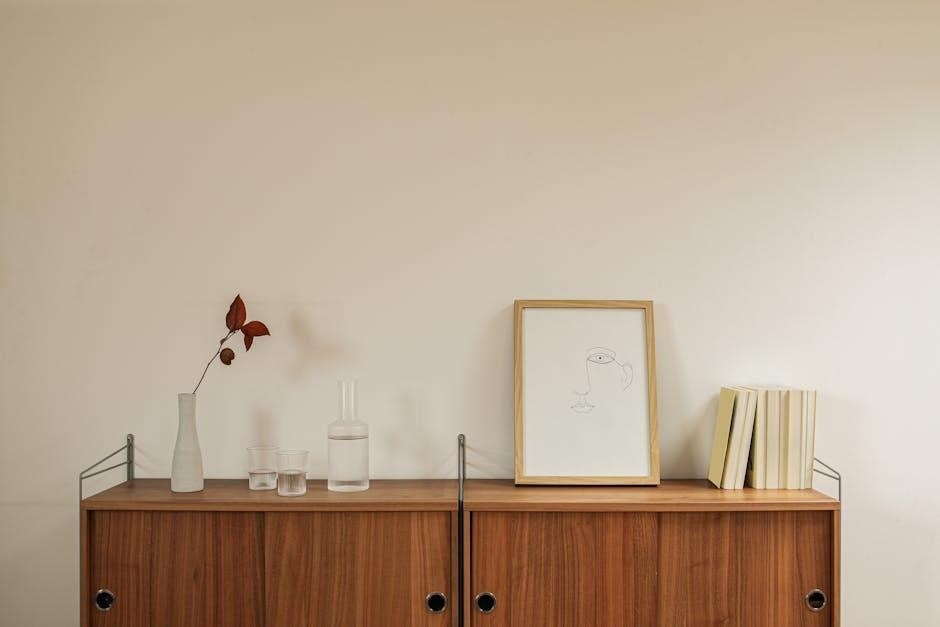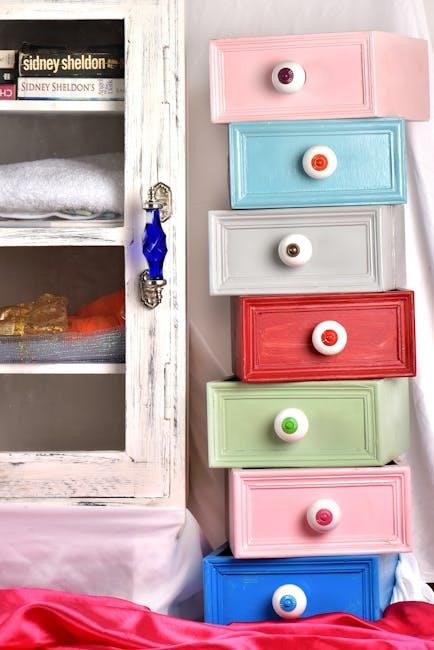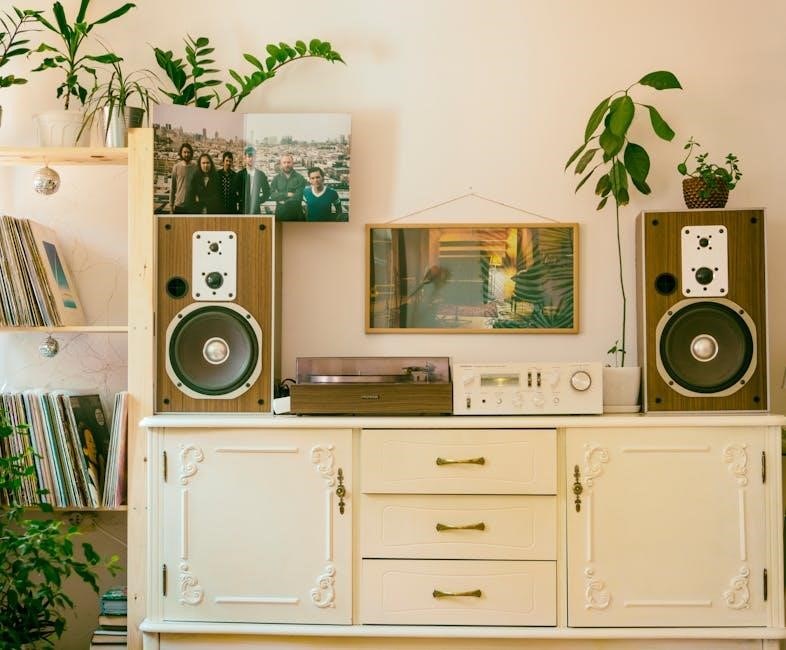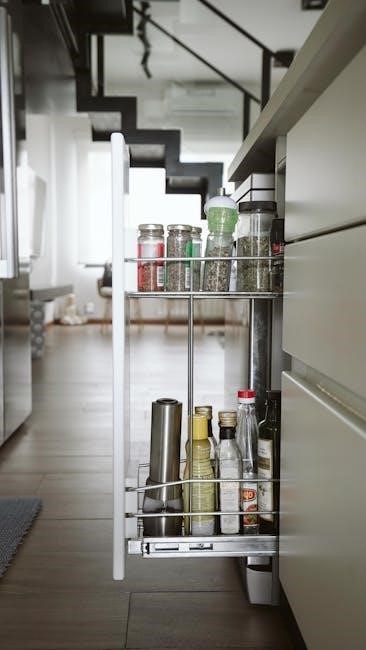Welcome to our comprehensive guide on cabinet pull placement! Proper placement enhances functionality and aesthetics, ensuring a balanced look․ Learn key factors and tips for perfect installation․

General Guidelines for Cabinet Hardware Placement
Cabinet hardware placement typically ranges from 1 to 4 inches from the edge, depending on the style, size, and desired aesthetic․ Proper alignment ensures functionality and visual balance․
Understanding the 1/3 Rule for Drawer Pulls
The 1/3 rule is a design guideline that divides drawer fronts into thirds to determine pull placement․ Placing pulls in the left or right third ensures balance and functionality․ This rule helps achieve a proportionate look, especially for larger drawers․ Using one oversized pull or two smaller ones in the designated thirds keeps the design consistent․ Proper alignment with this rule enhances both aesthetics and practicality, making drawers easier to use while maintaining a visually appealing arrangement․
Standard Placement Measurements (2․5 ౼ 3 Inches from Top or Bottom)
Cabinet pulls are typically placed 2․5 to 3 inches from the top or bottom edge of the drawer or cabinet door․ This standard measurement ensures functionality and aesthetic balance․ For upper cabinets, the pull is usually 2․5-3 inches from the bottom edge, while for lower cabinets and drawers, it’s 2․5-3 inches from the top edge․ This placement provides a comfortable grip and aligns with common design principles․ Adjustments may be needed for custom sizes or styles, but this range remains a reliable starting point for most installations․

Placement Considerations for Specific Cabinet Types
Different cabinet types require tailored hardware placement․ Upper cabinets often prioritize visibility, while lower cabinets focus on functionality․ Consider drawer size, style, and user accessibility for optimal results․
Upper Cabinets: Centering Knobs and Pulls
For upper cabinets, centering knobs and pulls is key for a polished look․ Measure from the edge or align with the door’s center for symmetry․ Use templates to ensure accuracy and consistency across all cabinets․ This placement enhances visual appeal and maintains a cohesive design, especially in modern kitchens․ Proper alignment also prevents hardware from looking misplaced, ensuring a professional finish․ Always consider the cabinet’s style and proportions when deciding placement․ This approach guarantees both functionality and aesthetic harmony, making your kitchen look well-designed and organized․ Proper alignment is crucial for a seamless appearance, so take your time during installation․
Lower Cabinets and Drawers: Optimizing for Functionality
For lower cabinets and drawers, functionality is key․ Place pulls 2․5 to 3 inches from the top or bottom for easy access․ This standard measurement ensures comfort and convenience․ Larger drawers may benefit from two pulls, spaced evenly to distribute weight․ Centering handles on wide drawers improves usability․ Consider the drawer’s size and usage when deciding hardware placement․ Proper positioning reduces strain and enhances daily use, making your kitchen more practical; Always align with the cabinet’s style to maintain a cohesive look while prioritizing functionality․ This approach ensures durability and ease of access over time․ Functionality should always guide your decisions for lower cabinets and drawers․

Style and Design Considerations

Style and design play a crucial role in cabinet pull placement․ Modern designs often favor centered pulls, while traditional styles may use knobs on doors and pulls on drawers․ Choose hardware that complements your cabinet style and personal aesthetic for a cohesive look․
Modern vs․ Traditional Placement Styles
Modern and traditional styles differ in cabinet hardware placement․ Modern designs often feature pulls centered on drawers and doors, emphasizing symmetry and clean lines․ In contrast, traditional styles may use knobs on doors and pulls on drawers, with hardware placed slightly offset for a classic look․ Both styles consider proportions and functionality, but modern placement focuses on visual minimalism, while traditional placement highlights ornate details․ Choosing the right style ensures a cohesive aesthetic that aligns with your kitchen or bathroom design․
Using Templates for Accurate Measurement
Using templates ensures precise cabinet pull placement, eliminating measurement errors․ Create or purchase a reusable template featuring common pull sizes and spacing․ Align it with the cabinet edge, mark the center point, and drill accurately․ Templates promote consistency across all cabinets, especially for multiple pulls․ They also simplify complex layouts, like double pulls on wide drawers․ For custom sizes, trace the pull’s screw holes onto cardboard and use it as a guide․ This method guarantees straight alignment and proper spacing, making installation efficient and professional-looking․

Hardware Size and Type
Choosing the right hardware size and type is crucial for functionality and aesthetics․ Pulls come in various lengths, while knobs suit smaller spaces․ Select hardware that complements cabinet style and size for a cohesive look․
Choosing the Right Size of Pulls for Different Drawers
Selecting the right pull size ensures functionality and visual harmony․ For smaller drawers, opt for pulls that are 1/3 the drawer’s width, while larger drawers may require longer pulls or two smaller ones․ Consider the drawer’s use and style when deciding․ Measure carefully to ensure pulls fit comfortably in your hand․ Using a template can help achieve precise placement․ Oversized pulls on wide drawers offer a sleek, modern look․ Always balance size with proportion to maintain a cohesive design․
Differences Between Knobs and Pulls in Placement
Knobs and pulls differ in placement due to their design and functionality․ Knobs are typically placed 1-4 inches from the edge of cabinet doors or drawers, centered for a clean look․ Pulls, often used on drawers, are placed 2․5-3 inches from the top or bottom, aligned horizontally․ For wider drawers, two pulls are commonly used, spaced evenly․ While knobs suit smaller spaces, pulls offer better grip and are ideal for deeper drawers․ Both should complement the cabinet style and size, ensuring a cohesive design that blends functionality with aesthetics․

Installation Tips

Precise measurement is key․ Use a tape measure and pencil to mark the center․ Drill accurately and secure hardware properly for a stable finish․
Drilling Holes Accurately
Drilling precise holes is crucial for proper hardware installation․ Use a template or measuring guide to ensure alignment․ Mark the center point with a pencil and clamp the cabinet door firmly․ Start with a small pilot bit to avoid splintering, then switch to the correct-sized drill bit․ For pull handles, measure the screw spacing carefully․ Double-check measurements before drilling to prevent errors․ Use a level to ensure holes are straight․ If drilling through thick material, apply steady pressure and maintain a slow, consistent pace․ Always test the drill bit on a scrap piece first․ Proper drilling ensures secure and even hardware installation․
Securing Hardware Properly
Securing hardware properly ensures durability and stability․ Start by aligning the pull or knob with pre-drilled holes, then insert screws or bolts․ Use a screwdriver to tighten firmly but avoid over-tightening, which can damage the cabinet․ For pulls with bolts, thread them through the hardware and cabinet, then secure with nuts on the backside․ Add washers to distribute pressure evenly and prevent loosening over time․ Double-check alignment and ensure hardware is flush with the cabinet surface․ Tighten in a crisscross pattern for even pressure distribution․ Properly secured hardware enhances both functionality and visual appeal, ensuring long-lasting performance․

Common Mistakes to Avoid
Common mistakes include incorrect measurements, ignoring hardware proportions, and over-tightening, which can damage cabinets․ Ensure proper alignment and use templates for consistency․ Avoid rushing the process․
Ignoring Hardware Proportions
Ignoring hardware proportions is a common mistake that can disrupt the balance of your cabinet design․ Hardware that is too small or too large for the cabinet size can look out of place and affect functionality․ For example, using oversized pulls on narrow drawers can make them difficult to grasp, while small knobs on large doors may seem insignificant․ Always consider the 1/3 rule and standard measurements to ensure hardware scales appropriately with the cabinet dimensions; Proper sizing ensures both aesthetic appeal and practical usability, avoiding a mismatched look in your kitchen or bathroom design․
Not Considering Cabinet Style and Size
One of the most critical mistakes in cabinet hardware placement is not considering the cabinet’s style and size․ Modern cabinets often require pulls to be centered or slightly offset for a sleek look, while traditional cabinets may benefit from knobs or smaller pulls․ Larger cabinets or deep drawers need hardware placed higher or lower to ensure easy access, while shallow drawers can have hardware centered vertically․ Ignoring these factors can lead to a mismatched appearance and poor functionality․ Always assess the cabinet’s dimensions and design before deciding on hardware placement to achieve a cohesive and practical result;
Proper cabinet pull placement is crucial for both functionality and aesthetics․ By following guidelines like the 1/3 rule, standard measurements, and style considerations, you can achieve a balanced and visually appealing design․ Remember to consider cabinet size, hardware proportions, and personal preference to avoid common mistakes․ A well-placed pull enhances usability and elevates your space’s look․ Take your time to plan and measure carefully, ensuring your hardware complements your cabinets and reflects your desired style․ With these tips, you’ll create a cohesive and functional design that stands the test of time․


